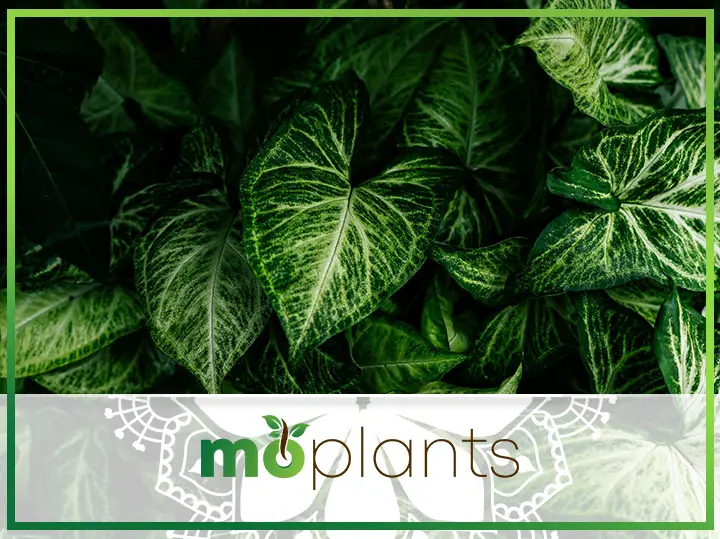A classic indoor plant with an easy-going nature and vibrant foliage, philodendron has always been popular among beginners and brown-thumbed gardeners. It is a common houseplant that needs no special attention and thrives under less than ideal conditions regardless of where you place it.
There are more than 450 known philodendron types, each boasting specific features and growth requirements. These plants are native to Central American and South American tropical forests, growing uninhibited under the canopy of sprawling trees.
The best thing about growing these houseplants is that they tell you exactly how they feel. If they need water, their leaves will begin to wilt or curl. Alternatively, if they are receiving too much or too little of the sun, the foliage color will help you determine if you should move the plant to another location.
These perennials can easily adapt to any environment. Whether you grow your philodendron outdoors or indoors, it will continue to mature and flourish – provided you live in a warm region or USDA zones 9 to 11, preferably.
Introduction: Philodendron
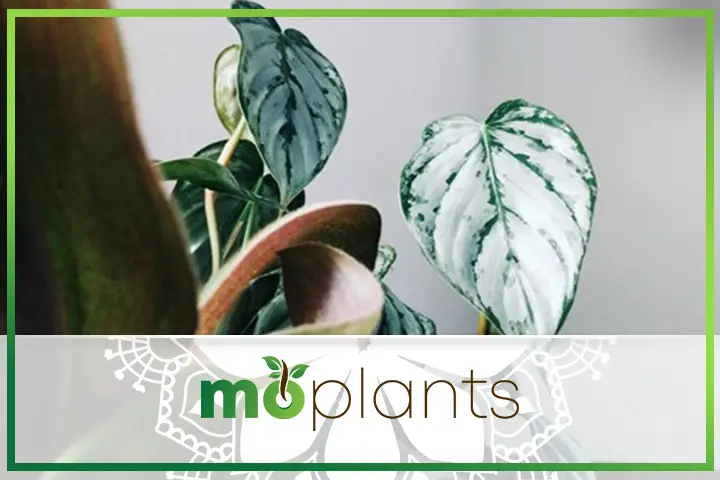
Philodendron is the second-largest genus of plants in the Araceae family, comprising hundreds of known and unknown attractive tropical species.
These houseplants’ low-maintenance and highly tolerant nature has made them a staple in contemporary and modern homes. You can find these plants with green, burgundy, chartreuse, and silver foliage, their unique hues allowing them to become the focal point of any room.
Moreover, most varieties feature large heart-shaped leaves with a velvety texture and glossy surface, adding to their iridescent charm and beauty.
These houseplants are usually classified into two main types:
- Vining Philodendrons
- Non-climbing Philodendrons
The vining variety needs a supporting structure such as a totem pole or trellis to climb. Blushing Philodendron and Heartleaf Philodendron are the most well-known species of the vining plant.
Meanwhile, the non-climbing variety grows upright and has an impressive width. These plants are usually called tree philodendrons and require more room to grow than the vining philodendrons.
Depending on their type, some of these plants can grow between three to eight feet, while others may reach the height of 20 feet. The potted and compact varieties usually grow between one to three feet tall.
Philodendrons are fast growers. While spring is the best season to propagate them, you can start growing this plant at any time of the year without a single worry. As long as you protect it from cold drafts and frost, this tropical beauty will continue adding color and freshness to your home décor.
How to Grow Philodendron Plants
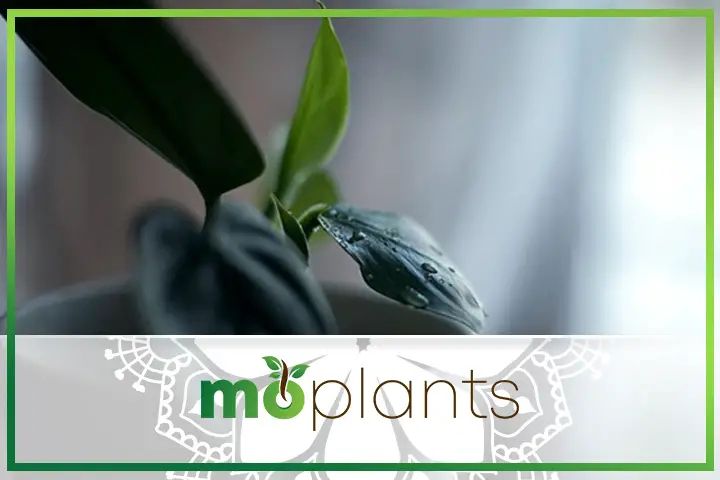
Here are some tips on how to grow philodendrons that you may find helpful.
Placement
Philodendrons love partial sunlight – or any environment that recreates the warmth and humidity of their native tropical habitat.
If you are growing these plants indoors, consider placing them near a window that receives bright but indirect light. Additionally, keep them away from cool drafts and heating vents.
Ideal Temperature
Philodendron care is easier than you may think. While this tropical plant grows well in an average home environment, it prefers temperatures between 70 and 80 degrees Fahrenheit. If you have placed your philodendron outdoors, make sure to bring it back indoors once the temperature drops below 55 degrees Fahrenheit.
Humidity Level
These lush tropical plants thrive in places with average humidity.
However, if you live in a particularly dry climate, consider misting your philodendrons every couple of days with plain water. Alternatively, you can buy a humidifier or place the container on a tray filled with pebbles and water. The pebbles will keep the plant’s roots from touching the water as the moisture evaporates and hydrates the plant throughout the day.
Exposure to Sunlight
As mentioned above, these plants require bright but filtered light to grow. If you place them in a particularly sunny spot that gets intense sunlight, the leaves will start turning yellow before falling off.
On the other hand, if your plant doesn’t receive sufficient sunlight, it may become leggy.
Watering Frequency
While philodendrons appreciate moist soil, overwatering can potentially kill them.
Therefore, you should only water these houseplants once the top inch of the soil has completely dried out. Typically, it would help if you watered your philodendrons once a week during summer. As the weather gets colder, reduce your watering frequency to prevent shedding and root rot.
Moreover, don’t forget to discard the excess water.
Potting Mix
Philodendrons prefer loamy and well-drained soil that is acidic in nature. Since these plants are sensitive to salts and minerals in the soil, please make sure to flush out any impurities that may have settled in the potting mix every couple of months.
Infographic
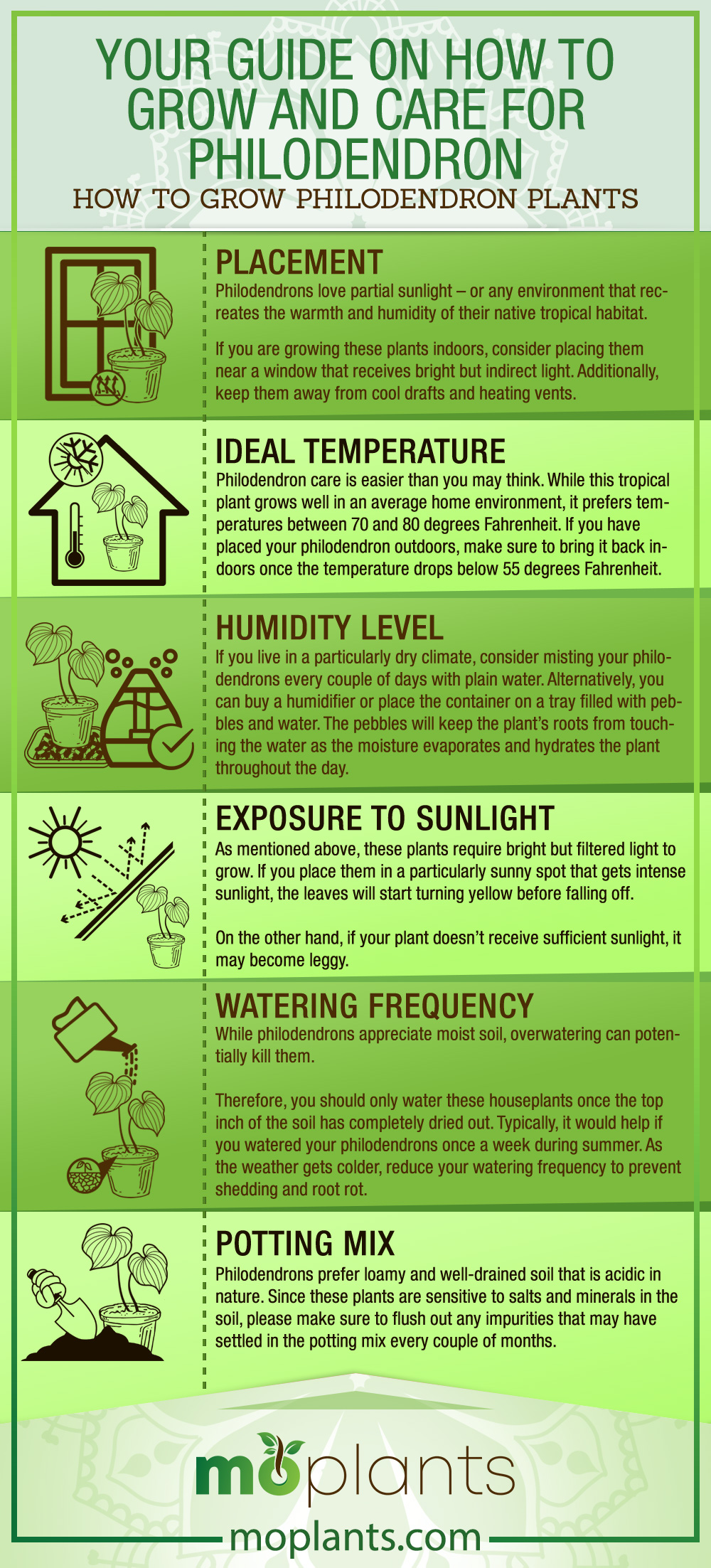
Philodendron Propagation Method
Whether you are a beginner or a seasoned gardener, this philodendron propagation technique will help you expand your home garden without any hassle.
The first step to propagating this plant is cleaning the tools. It is important to wash and sterilize the knife before cutting the plant. It will reduce the chances of any infection or infestation. Next, choose a stem or stalk that has developed an aerial root and cut it about five centimeters below the root.
Meanwhile, if the plant does not have aerial roots, you can cut a healthy stem at an angle to encourage new growth. Make sure the cutting only has a few leaves attached to the tip. You can then dip the cut end of the plantlet into a growth hormone to stimulate quick root development.
Now, put the cutting into a vase filled with water. The cut end must be immersed in the liquid, but the leaves should be above the surface. If any of the leaves are touching the water, please consider removing them.
Make sure to replace the water once a week and keep an eye on the cutting. Typically, it takes about three to four weeks for the roots to sprout. As soon as you notice the growth, move the cutting to a small container with fresh potting media.
Philodendron Care Tips
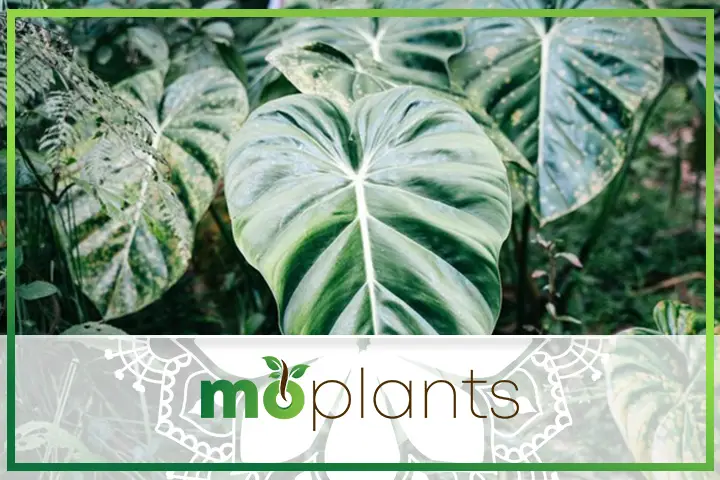
Let’s look at some simple and easy philodendron care tips:
Pruning and Trimming
Does your plant look too leggy or asymmetrical? If so, you may want to prune it.
The best time to prune and trim your tropical houseplant is during summer and spring. It would help if you considered using sterilized scissors to remove the damaged or yellowing leaves.
It is also important to cut the stems above the leaf node to ensure your plant grows well.
Cleaning the Plant
The large and shiny leaves of philodendron plants are dirt magnets. Therefore, you must clean them regularly to ensure the foliage looks fresh and healthy at all times.
You can mist the plant and wipe the dirt with a soft cloth to achieve the best results.
Fertilizer
Since philodendrons are fast growers, they appreciate being fed with a rich organic fertilizer every month during the summer and spring season. In the winter months, feeding your plants every six to eight weeks would be more than enough.
Repotting
Our last philodendron care tip is repotting the plant once it becomes root-bound. Ideally, it would be best to move the plant to be bigger container every year or so.
Nevertheless, if you are confused whether your plant needs a new pot, look for any signs of roots poking through the soil. If you notice any tendrils appearing through the drainage hole, gently remove the plant from its current container and move it to a new one that is at least a size bigger. Fill the new container with fresh potting medium and water the plant thoroughly.
Infographic
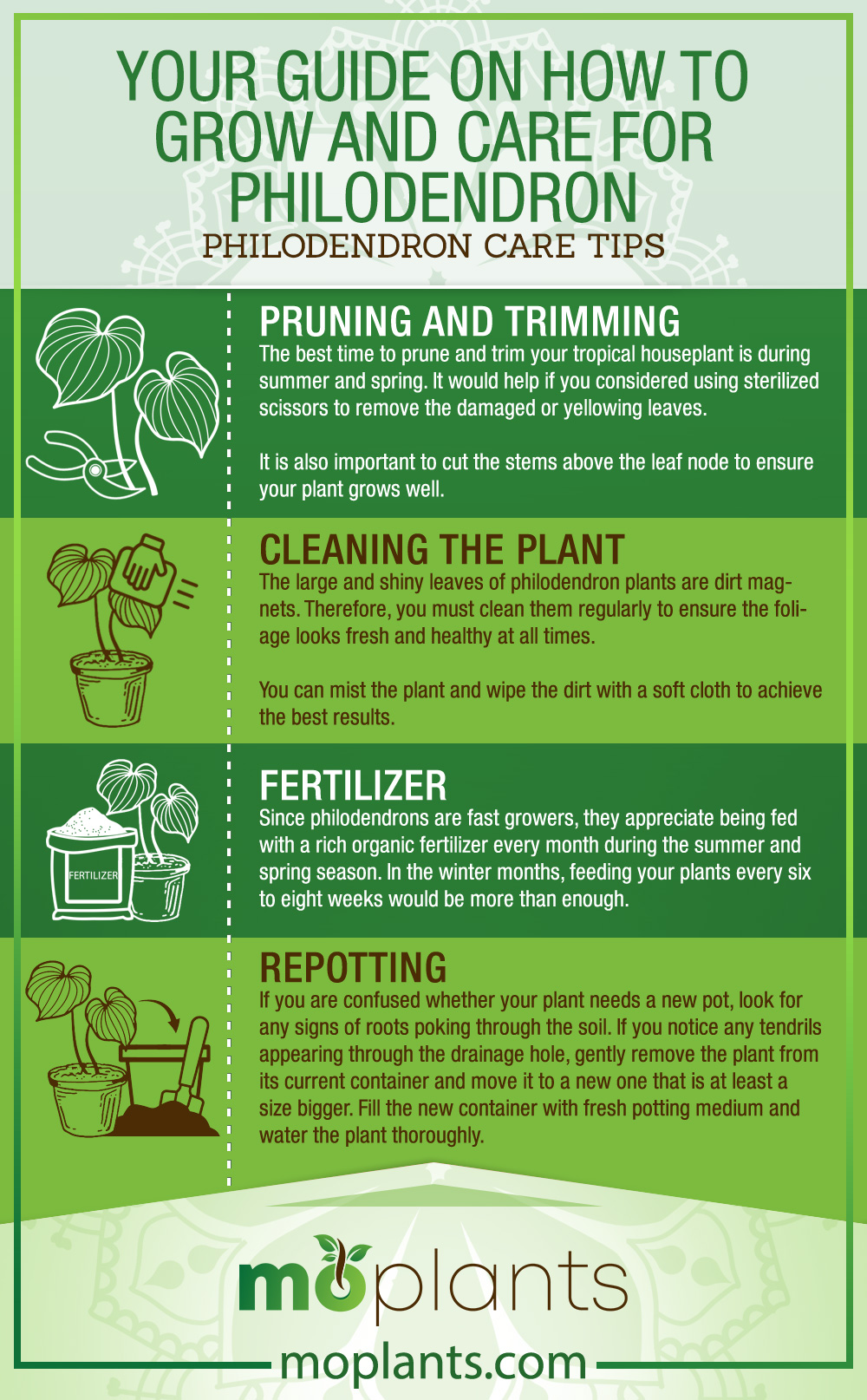
Philodendron vs. Pothos
Although philodendrons and pothos may look alike, they are not the same plant.
The easiest way to tell them apart is through their leaves. While philodendrons have dramatic heart-shaped leaves with pointed tips, pothos leaves are larger and lack prominent tips. In addition, the philodendron leaves are relatively thin, smooth, and velvety. Meanwhile, pothos has thicker leaves with a waxy texture.
Now that we know all about philodendron vs. pothos, let’s move on to our next point.
Are Philodendrons Toxic?
While they are easy to maintain and look after, philodendrons can be toxic to children and pets alike. The plant contains calcium oxalate crystals, which can be extremely harmful if ingested.
Common Signs of Philodendron Poisoning
Some of the most common signs of philodendron poisoning among pets include:
- Oral irritation
- Excessive drooling
- Dilated eyes
- Hoarse voice
- Shortness of breath
- Pawing at face
- Swollen tongue
- Vomiting
- Cardiac arrhythmia
- Diarrhea
If your cat or dog exhibits any of these symptoms, please make sure to consult a vet immediately. In addition, if you suspect your child has chewed or eaten a portion of your philodendron, please visit a nearby clinic or ER.
Common Philodendron Problems and How to Solve Them
These are some of the problems you may encounter while growing philodendron outdoors or indoors.
Yellowing Leaves
There could be several reasons why the leaves of your philodendron may be getting yellow.
For starters, the plant may not be receiving enough sunlight or maybe receiving a lot of it. If the mature leaves at the top have turned yellow, it could indicate dehydration, which means you need to water the plant more often. However, if the younger leaves at the bottom have become, it could be a sign you are overwatering the plant.
The chemicals in fertilizers can also cause the roots to burn, resulting in yellowing foliage.
Consider moving your plant to a different spot and adjust your watering frequency accordingly to take care of this issue.
Browning Leaves
If your plant has developed brown foliage, you are likely overwatering it.
To counter this problem, move your plant to a brighter location and cut back on watering. Also, use room temperature water for your philodendrons, as cold water can shock the roots.
Moving on, if the leaves are turning brown and curling at the edges, it may indicate that the foliage is receiving intense sunlight for prolonged hours. To fix this issue, consider placing the plant in a humid environment and keep the soil moist.
Common Pests and Diseases
Philodendrons are not prone to any specific pests or diseases. However, they may be susceptible to aphids, mealybugs, scales, spider mites, and thrips. If that happens, you can wash the foliage with neem oil or insecticidal soap.
Popular Philodendron Types
Let’s look at some of the most popular philodendron types that can add a hint of elegance and sophistication to your interior design.
Philodendron Birkin
A new hybrid variety, Philodendron Birkin plants are compact, beautiful, and slow-growers. They have deep green variegated leaves that are round in shape and feature short pointed tips. The bright stems and glossy foliage make this plant an excellent addition to any home or office.
It is also worth mentioning that each leaf of Philodendron Birkin boasts crisp cream-colored lines. Hence you can’t find two identical leaves in the same plant. In addition, they don’t need external support and typically top out at three feet.
Philodendron Golden Goddess
Another exotic hybrid plant, Golden Goddess is one of the most dazzling philodendron types. It is commonly known as Lemon Lime Philodendron and was first created in Thailand.
This tropical plant is known for its distinctive golden-yellow leaves that grow on vining stems. This feature makes it an ideal houseplant to display in hanging baskets. In an average home environment, Golden Goddess Philodendron can grow as tall as six feet.
Philodendron Brasil
Philodendron Brasil gets its unique name from its vibrant leaves that resemble the Brazilian flag. It is another popular hybrid variety that features exquisite green and yellow heart-shaped foliage. In addition, it is a trailing plant that is easy to grow and maintain indoors.
Brasil is among the compact philodendron types and can grow up to three feet tall.
Philodendron FAQs
These are the most frequently asked questions about philodendron care and growth. Let’s take a look:
Do philodendrons need sunlight?
Yes, philodendrons need bright, indirect light to thrive. Although they are native to tropical regions, these plants may start losing their leaves and become leggy if you place them in a dark corner with no light or fresh air.
Do philodendrons purify the air?
Yes, the large-leafed varieties of philodendron plants help improve indoor air quality by absorbing all the toxins and pollutants in their surroundings.
Are philodendrons good indoor plants?
These gorgeous ornamental plants can be a perfect addition to any room or workspace. You can place them in your hallway, living room, dining area, bedroom, home office, or reading nook, among other areas. The vibrant foliage of your philodendron can instantly brighten up any dull corner of your home while adding texture to your interior design.
To summarize, philodendrons are easy to look after and grow indoors. They are generally forgiving of neglect and can acclimate to almost any environment. You can also find these plants in different colors, shapes, and sizes at your local nursery. Just make sure to place them in a bright spot and allow the soil to dry between each watering. Also, don’t forget to feed and prune your plant to keep it healthy.

